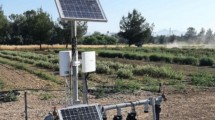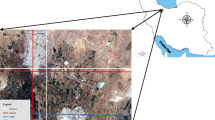Abstract
The Angström-Prescott (AP) model is widely suggested for estimating global solar radiation (R s), especially for reference crop evapotranspiration (ET0) calculations. Many previous studies indicated that the coefficients of the AP model depend on the climatic and geographical characteristics of study sites. In the present work, calibrated AP models were developed in some climates in Iran. Different radiation scenarios from estimated and measured R s were applied to calibrate the AP coefficients. Radiation scenarios included measured R s (M) and estimated R s from the models of Daneshyar (D) and Hargreaves (H). Daily reference evapotranspiration was calculated using the coefficients obtained from different R s scenarios. The estimated daily ET0 values were compared with field lysimeter data for validation. Results showed that scenarios D and H present the minimum ET0 deviation from lysimeter data. Findings suggested that at the majority of the study sites, calibration of the AP model improved the accuracy of estimated ET0. Results also indicated the applicability of reliable R s estimation methods to calibrate the AP model. Apart from applied R s scenarios, the daily ET0 is underestimated by the FAO56 Penman-Monteith model.




Similar content being viewed by others
References
Allen RG (2000) Manual of REF- ET: reference evapotranspiration calculation software. University of Idaho
Allen RG, Pereira LS, Raes D, Smith M (1998) Crop evapotranspiration—guidelines for computing crop water requirements. FAO irrigation and drainage paper 56. Agriculture Organization of the United Nations, Rome
Almorox J, Hontoria C (2004) Global solar radiation estimation using sunshine duration in Spain. Energy Convers Manag 45:1529–1535
Almorox J, Benito M, Hontoria C (2008) Estimation of global solar radiation in Venezuela. INCI 33(4):280–283
Angstrom A (1924) Solar and terrestrial radiation. Q J Roy Meteorol Soc 50:121–125
Belcher BN, DeGaetano AT (2007) A revised empirical model to estimate solar radiation using automated surface weather observations. Sol Energy 81(3):329–345
Boisvert JB, Hayhoe HN, Dube′ P (1990) Improving the estimation of global solar radiation across Canada. Agric Meteorol 52:275–286
Hargreaves GH, Samani ZA (1982) estimating potential evapotranspiration. J Irrig Drain Eng ASCE 108(3):223–230
Iqbal M (1983) An introduction to solar radiation. Academic, New York
Islamic Republic of Iran Meteorological Office (IRIMO) (1980–2007) Annual year book reports, Data Center, Tehran, Iran.
Jafarpur K, Yaghoubi MA (1989) Solar radiation for Shiraz, Iran. Sol Wind Technol 6(2):177–179
Khalili A, Rezai-e Sadr H (1997) Estimation of global solar radiation over Iran based on climatological data. Q J Geogr Res 3:15–35 (in Persian)
Kjaersgaard J (2007) Estimation of energy balance components for surfaces with low vegetation. Dissertation, University of Copenhagen
Liu X, Mei X, Li Y, Wang Q, Zhang Y, Porter JR (2009) Variation in reference crop evapotranspiration caused by the Angström-Prescott coefficient: locally calibrated versus the FAO recommended. Agric Water Manag 96(7):1137–1145
Malek E (1979) Determination of the constants for the global radiation equation at Badjgah, Iran. Agric Meteorol 20:233–235
Moradi I (2009) Quality control of global solar radiation using sunshine duration hours. Energy 34(1):1–6
Persaud N, Lesolle D, Ouattara M (1997) Coefficients of the Angstrom–Prescott equation for estimating global irradiance from hours of bright sunshine in Botswana and Niger. Agric Meteorol 88:27–35
Prescott JA (1940) Evaporation from a water surface in relation to solar radiation. Trans Roy Soc Sci Aust 64:114–125
Sabziparvar AA (2008) A simple formula for estimating global solar radiation in central arid deserts of Iran. Renew Energy 33:1002–1010
Sabziparvar AA, Shetaee H (2007) Estimation of global solar radiation in arid and semi-arid climates of East and West Iran. Energy 32:649–655
Sabziparvar AA, Mousavi R, Marofi S, Ebrahimipak NA, Heidari M (2013) An improved estimation of the Angstrom–Prescott radiation coefficients for the FAO56 Penman–Monteith evapotranspiration method. Water Resour Manag 27(8):2839–2854
Samani Z (2000) Estimating solar radiation and evapotranspiration using minimum climatological data. J Irrig Drain Eng 126(4):265–267
Trnka M, Eitzinger J, Kapler P, Dubrovský M, Semerádová D, Žalud Z, Formayer H (2007) Effect of estimated daily global solar radiation data on the results of crop growth models. Sensors 7:2330–2362
Wu SH, Yin YH, Zheng D, Yang QY (2006) Moisture conditions and climate trends in China during the period 1971–2000. Int J Climatol 26(2):193–206
Yin Y, Wu S, Zheng D, Yang Q (2008) Radiation calibration of FAO56 Penman–Monteith model to estimate reference crop evapotranspiration in China. Agric Water Manag 95:77–84
Acknowledgments
The authors wish to thank the Islamic Republic of Iran Meteorological Office (IRIMO) Data Center for providing the weather data. Authors also the appreciate Agricultural Research, Education and Extension Organization (AREEO), for providing the lysimeter data. This work was financially supported by the Office for Research and Technology (ORT), Bu-Ali Sina University, Hamedan, Iran.
Author information
Authors and Affiliations
Corresponding author
Appendix
Appendix
The statistical methods used were as follows:
where P i and O i are the ith predicted and observed values, respectively; \( \overline{O} \) is the observed daily averaged value; and n is the total number of observations.
Rights and permissions
About this article
Cite this article
Mousavi, R., Sabziparvar, A.A., Marofi, S. et al. Calibration of the Angström-Prescott solar radiation model for accurate estimation of reference evapotranspiration in the absence of observed solar radiation. Theor Appl Climatol 119, 43–54 (2015). https://doi.org/10.1007/s00704-013-1086-7
Received:
Accepted:
Published:
Issue Date:
DOI: https://doi.org/10.1007/s00704-013-1086-7




